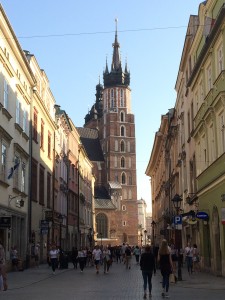
My first glimpse of Krakow. Many people enjoy the beautiful Monday afternoon by sunbathing by the Vistula river.
When I first arrived in Krakow I have to admit, I did not know what to expect; maybe if I had bothered to google the city before I left, I may have had an idea of what Krakow was like before I arrived. This year was the first time that the World War II study abroad program has added a Poland leg of the trip so I did not even have the experience of a previous year to reference. I had a couple of different assumptions of what Krakow might be like. On one hand I thought it might be another Bayeux: a storybook village in the middle of a nowhere that offered more charm than actual things to do. I also could not help but picture what I feel many people imagine when they think of an eastern European town: a grey urban center filled with identical dilapidated apartment buildings left over from the Cold War era. Let’s face it, it was probably a bit of a misstep on my part to go into this city completely blind.

Cloth Hall, which dates back to the 13th century, is the central feature of the main market square in Krakow.
Krakow turned out to be neither of those assumptions and I happy to say that I was pleasantly surprised with what I got. Krakow is a city filled with vibrancy and life. My first glimpse of what life in Krakow was like came when, as we drove into the main part of the city, I spotted a number of younger people sunbathing by the Vistula River that runs through the city. Once we got a chance to go out and explore the city some more I found a sprawling green park, brightly colored buildings, a number of restaurants and shops, and a large outdoor market space in the city square. Already within a few minutes of being in Krakow and both of my assumptions of the town were already proven false. Krakow is not a tiny village but a large metropolitan area with a lively city center and filled with a surprising number of people around my age; I was wrong again in assuming that the majority of the population would be on the older side.

The streets of Krakow are a beautiful mix of old world and new world. St. Mary’s Basilica- originally built during the 13th century -rises up in between the modern buildings of Krakow.
Perhaps one of my favorite things about Krakow is that it’s a city that mixes modernity and medieval and makes it work. The city is a patchwork of modern buildings, Gothic cathedrals, and medieval castles. In some places across Europe I’ve noticed similar mixes of the past and the present in the architecture but nowhere else has it worked as nicely as it does in Krakow.
The only real complaint I have about the city seems to be when it comes to currency. For whatever reason the smallest bill the ATM’s are able to give out are a 50 zloty bill. That would not be a big issue if it weren’t also for the fact that change at restaurants and shops across town seem to be hard to come by, which makes paying for things a bit of a headache. But if the minor currency issue is the only complaint I have about Krakow, it goes to show how lovely of a city Krakow really is.
